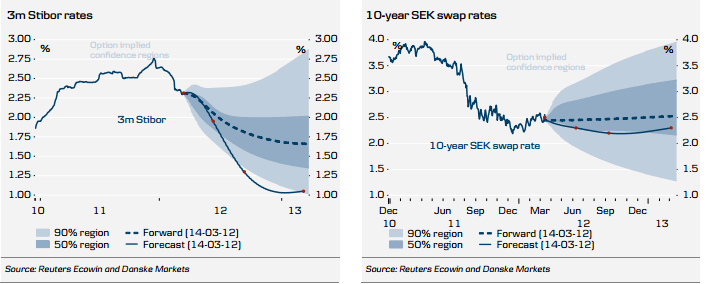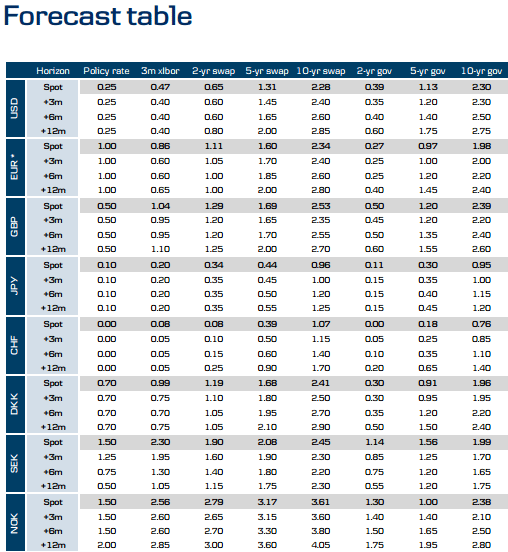Eurozone forecastGrowth and inflation
The economic data are consistent with a recent stabilisation of the economic growth in the eurozone, albeit at low levels. Q4 data confirmed our expectation of a drop in GDP of 0.3% q/q. We expect the recession to be short and the euro area to return to positive growth rates in Q2. Headwinds from fiscal tightening and credit tightening will continue to weigh on growth. However, LTRO II has brought substantial relief to financial markets and has helped prevent a severe credit crunch. We expect the euro area economies to grow only at 0.3% in 2012. Following the recent increase in the oil price we have revised our inflation outlook upwards. Inflation is expected to remain above the 2% target in 2012 before edging below 2% in 2013.
Monetary policy and money markets
In March the ECB kept the leading interest rate unchanged at 1%, as expected. We expect the ECB to keep rates on hold until 2014 – as the economy slowly recovers. Most analysts have reviewed their outlook in this direction and most seem to agree that the ECB will be on hold for a long period of time. The 3Y liquidity tenders carried out in December and February have brought significant relief to financial markets and will support lower Euribor fixings in the coming quarters and keep shorter-dated swap rates low. Our forecasts for 3M Euribor fixings are slightly below forwards in the short end of the curve across forecast horizons.
Yield curve
We believe that 10Y US rates have troughed now and we see increased upside risks to long-dated US rates. This is expected to rub off on longer-dated EUR swap rates relatively speaking. We therefore expect to see a moderate rise in the EUR swap rates going forward. As lower fixings are keeping a lid on short-end swap rates, we expect a steeper swap curve. On a 3M horizon, our forecasts are in line with forward markets, while they are above forwards on 6M and 12M horizon.
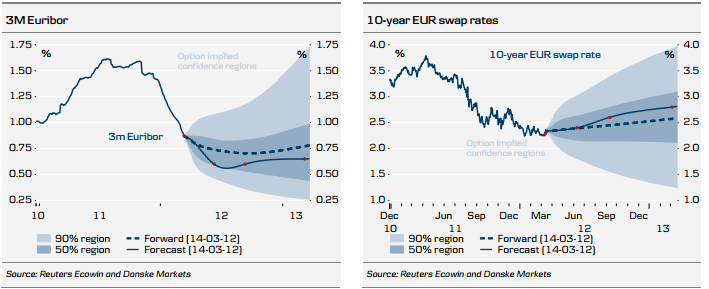
US forecast
Growth and inflationData out of the US are currently sending mixed signals. Growth data (private consumption, CAPEX and trade) point to a weak Q1 with GDP growth around 1.5%, while job data continue to improve and non-farm payrolls have averaged 245,000 over the past three months. Looking forward, we expect growth to rebound in Q2 as a better job market, increasing credit growth and a stabilisation in housing will support private consumption. The main risk to our relatively upbeat forecast is a new surge in oil prices. Inflation pressures have eased somewhat recently, as commodity prices have declined. Pricing power is poor and wage increases very muted. We are past the peak in core inflation and expect to see a decline towards 1.6% over the course of 2012.
Monetary policy and the money market
We expect the Fed to remain on the sidelines for now, as the economy is recovering. That said, the central bank will keep the door open for further easing, should the recent improvement in the labour market turn. We do not expect further easing in 2012, but it is still possible if the fragile recovery faces new headwinds. The money market is pricing a first fed funds hike to 0.5% by late spring 2014 – although the Fed will be on hold for a very long time, we believe that there is room for higher money market forward rates over the next 12 months. USD libor fixings have almost stabilised and we believe that there is now limited downside to the 3M rates.
Yield curve
Despite easing stress, improving macro data and higher oil prices, US rates remain historically low but in our view the risk of a sell-off is increasing. As the economy continues its modest recovery, the expectations of another round of QE are likely to be scaled down. As this happens, we believe that long US rates will break out of the current very tight range and move higher. Alongside this, we forecast a steeper curve. Generally, we have made very few adjustments to our forecasts. The two-year swap rate forecast has been adjusted slightly up as fixings are showing signs of stabilising and the chance of QE3 is declining. Our forecast for tenors longer than five years is above the forward market, with the biggest difference in a 12-month time-horizon.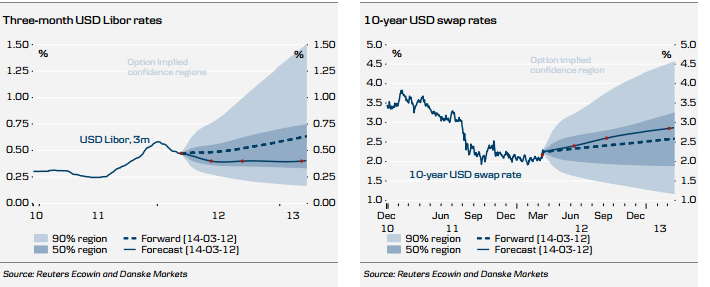
UK forecast
Growth and inflationThe UK will most likely avoid a technical double-dip recession. Q4 GDP shrank 0.2% but private consumption rose for the first time since Q3 2010 and exports picked up faster than predicted by forecasters. We believe that Q1 will be slightly positive, around 0.1- 0.2%. H2 looks to be positive too. CPI peaked at 5.2% in this cycle and has rapidly fallen to 3.6% because of base effects and the VAT effect dropping out. Inflation will most likely continue lower towards BoE’s 2% target by year-end. With oil prices on the rise, itis now less certain that inflation will fall below the target.
Monetary policy and the money market
The Bank of England continues its quantitative easing programme. By the beginning of May the Bank of England will have purchased Gilts for a total of GBP325bn. Monthly buying is GBP16.7bn. We expect the Bank of England to lift the asset purchase target again in May, either by GBP50bn or GBP25bn. The latter would be to signal a soft landing. Rate hikes are not on the agenda before 2014 but some members of the Monetary Policy Committee might take a hawkish stance by the end of the year, which makes sense as the Bank’s inflation fighting image has been scratched in recent years. The conditions in the money market are currently easing and LIBOR rates are slowly coming lower. The ECB’s 3Y LTROs probably has played a big role here and the interbank market is still not in great shape.
Yield curve
The BoE adjusted its purchase strategy in February and changed the boundaries between maturity sectors – a “reverse operation twist”, where it would buy more shorter-dated securities and fewer longer-dated. Accordingly, we thought the yield curve would steepen but this has not happened, perhaps a consequence of global yield curve flattening that has dominated. Given the outlook for further economic recovery, we now instead believe the 5-10 year curve will flatten, closer to its historical average. As we have argued since the beginning of the year, we believe the yield on the 10Y note will remain low, probably in the well-known 1.95-2.25% range. 
Denmark forecast
Growth and inflationThe Danish economy expanded 0.2% q/q in Q4 11 on the back of a marked improvement in private consumption and a further increase in exports. Following the debt crisis turmoil in the second half of last year, the Danish economy thus looks set to have avoided a new economic downturn. Looking ahead, we expect the slow but positive growth to continue as especially the Danish manfucaturing continues to perform well. Inflation remained unchanged in February at 2.8% y/y. Higher taxes and gasoline prices are keeping inflation elevated. The Danish budget deficit for 2011 looks set to comply with the EU criteria of 3% of GDP despite clear expectations of the opposite. Higher revenue from tax on pension returns has cut the deficit to around 2.5% .
Monetary policy and money markets
The general risk sentiment has improved over the past month and EUR/DKK has moved a little higher, reducing the chance of a new independent Danish rate cut in the near term. Our main scenario is still that the repo rate will remain unchanged at 0.70% throughout 2012, although there is still a risk of a new rate cut. The Cibor fixings have remained stable since the beginning of the year and the fixing spread to the eurozone has thus turned positive again, as we expected in the February forecast. Going forward, we expect Cibor fixings to resume a moderate downtrend as more liquidity is coming to the markets in the coming month with the Danish central bank supplying unlimited amounts of 3Y liquidity by end-March 2012.
Yield curve
Danish bonds have continued to underperform German bonds over the past month and the swap spread between Denmark and Germany turned more positive. A key driver for the spread widening has been the ongoing improvement in risk sentiment, which has reduced safe-haven flows into Danish markets. Going forward, we expect Danish rates to trade in tandem with German rates. Our forecasts are in line with forward markets on a 3M and 6M horizon, while they are above forwards on a 12M horizon.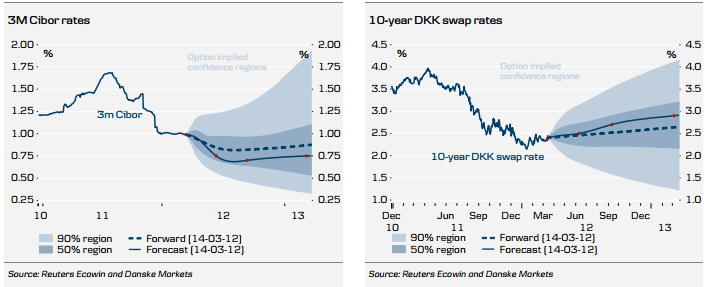
Sweden forecast
Growth and inflationSwedish GDP fell by as much as 1.1% in Q4 from the previous three-month period. At face value that was very close to what we expected but at a detailed level, the outcome was in some respects worse. We had anticipated a negative contribution from inventories but in fact the opposite turned out to be the case, something we would assume was not planned and may weigh on the current quarter. At the same time, it appears obvious that the labour market is deteriorating. Seasonally-adjusted unemployment was 7.6% in January – up only three-tenths of a percentage point since the lows seen late in 2011 but the trend seems clear and combined with survey data it seems quite likely that labour market conditions will deteriorate further. The slowdown no longer concerns just manufacturing– in the past two months through January, service producers’ output has declined too.
Monetary policy and the money market
As in December, the Riksbank decided to cut the repo rate by 25 basis points at the February policy meeting and (again) showed a rate forecast of unchanged policy over the coming year or so. The Riksbank remains very split with two board members advocating for more aggressive cuts while the remaining four members seem reluctant to act. On the other hand, one must consider the fact that the drop in Q4 GDP was much steeper than the RB had projected (the RB looked for -0.4% q/q) and in addition, inflation has come in considerably below forecast as well. If – as we suspect – unemployment increases somewhat more than according to the RB forecast, it will be very difficult for the central bank to explain why policy should be on hold given its policy mandate. The market is currently more or less pricing in a full 25bp cut in April and we are in agreement with this.
Yield curve
Repo rate cuts equal to some 40bp have been discounted by the market over the next four meetings. We believe that the bond curve will gradually steepen during the course of next year. However, the outcome of the introduction of SGB1056 will probably be decisive for curve movements in the short term. A combination of lower short rates and eventually somewhat higher long-dated rates should get the bond curve steeper. A low inflation rate and Riksbank cuts suggest lower rates at the front end. Moreover, supply will be directed towards the long end of the curve, whereas supply in the short end will shrink when the SGB1046 matures in October. We believe this is supportive for short-end bonds and curve steepeners in the medium to longer term.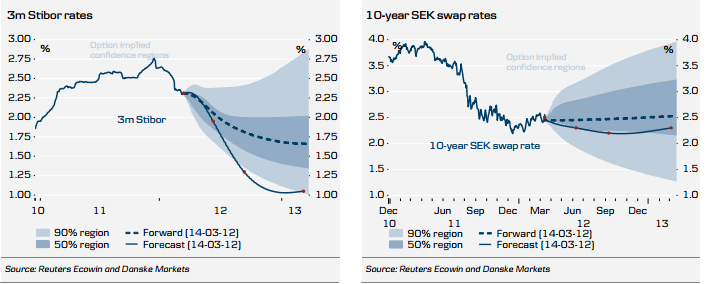
Norway forecast
Growth and inflationAs the oil price is holding up, oil investments and solid growth in national income is counteracting the negative effect on the export sector from the European debt crisis. Hence, capacity utilisation is close to normal and growth is expected to be above trend in 2012. The latest key figures support this view. The recoil in the PMI in January and February reduces the downside risk stemming from subdued global growth and rising house prices underscore the fact that real interest rates are too low to be sustainable. In addition, private consumption picked up significantly in January after a period of moderate growth. The continued tightening of the labour market illustrates that growth is above trend and that the probability of a drop in wage growth is diminishing. Core inflation is still moderate, but downside risks seem limited as cost inflation remains in place and consumption growth hovers around 3%.
Monetary policy and the money market
As downside risks are diminishing and the housing market and household debt continue to expand, we had expected Norges Bank to leave policy rates unchanged in March.However, the recent appreciation of the Norwegian krone has obviously made NB sufficiently nervous to trigger another rate cut of 25bp to 1.5 %. According to the renewed interest rate path from NB, the first hike is planned in 20013Q2. However, based on the continued improvement in the key figures, we still expect NB to hike rates earlier than this.
Yield curve
We expect the Norwegian 2-10 swap curve to steepen over the course of 2012, but not as much as the US curve. Following a further, but limited decline, we expect the short end rates to move higher in the second half, as further cut expectations gradually fade out. We expect the long end of the curve to have bottomed out in line with European and US longer-dated rates.